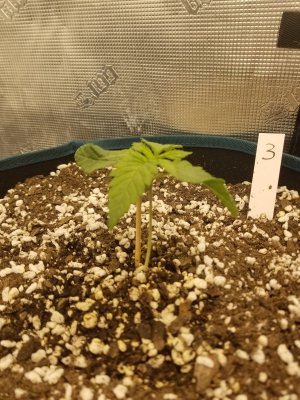

Avoid plants with roots that are brown and growing around the bottom of the container. Use high-quality seed and transplants.Plant in well-drained soil high in organic matter.Providing optimum conditions for good growth at this early stage will help ensure healthy growth and good yields through the season. Drought, sustained winds, waterlogged soil, poor quality transplants, temperature extremes, and cloddy or compacted soils high in clay can all cause the stunting of young seedlings or transplants.Check the last frost date in your area before planting. Gardeners should be prepared to protect young plants from the elements as suggested in the bullet below. Unexpected late frosts and cold soil temperatures can injure or stunt young plants. This tends to happen if seedlings or transplants are planted too early. Problems caused by nonliving factors (weather, drought, wind, etc) Weather-damaged tomato transplant Infected plants should be pulled up immediately, indoors or out in the garden, and composted. This treatment will make them more susceptible to soil pathogens. However, do not pre-soak bean and corn seeds in water. When the radicle (new root) begins to develop, remove seeds and plant in garden soil. Check the germination rate after 5-7 days. Roll up the paper towel, place it in a plastic bag with some holes and set it on top of the refrigerator. Seeds can also be pre-sprouted to give them a head start. If you've had a problem with damping-off, mix in aged compost but avoid incorporating un-decomposed organic materials prior to planting (straw, leaves, fresh manure, etc.). Plant on raised beds if your garden soil stays wet for days following rainfall. IN THE GARDENĪvoid planting seeds or transplants in low-lying, poorly drained areas.

Plant seeds and transplants in loose, well-drained soil. Allow the top of the growing mix to dry slightly before watering. Don't overwater seedlings grown indoors or in a greenhouse or cold frame. Use soilless potting media for growing transplants. Management of damping-off TRANSPLANTS AND SEEDLINGS Damping-off is more likely to infect large seeds (corn, bean, pea).


Symptoms are more likely to be observed on slow-growing, weak plants. In the garden, the disease can be a problem on poorly drained soils during cool, wet, and cloudy spring weather.Seedlings grown inside homes under fluorescent lights and in greenhouses succumb to damping-off if the media is poorly drained and kept too wet.Damping-off can affect seeds in the ground prior to germination as well as young seedlings.
Corn seedlings falling over free#
These pathogens are water molds - they must have free water to grow and reproduce.


 0 kommentar(er)
0 kommentar(er)
